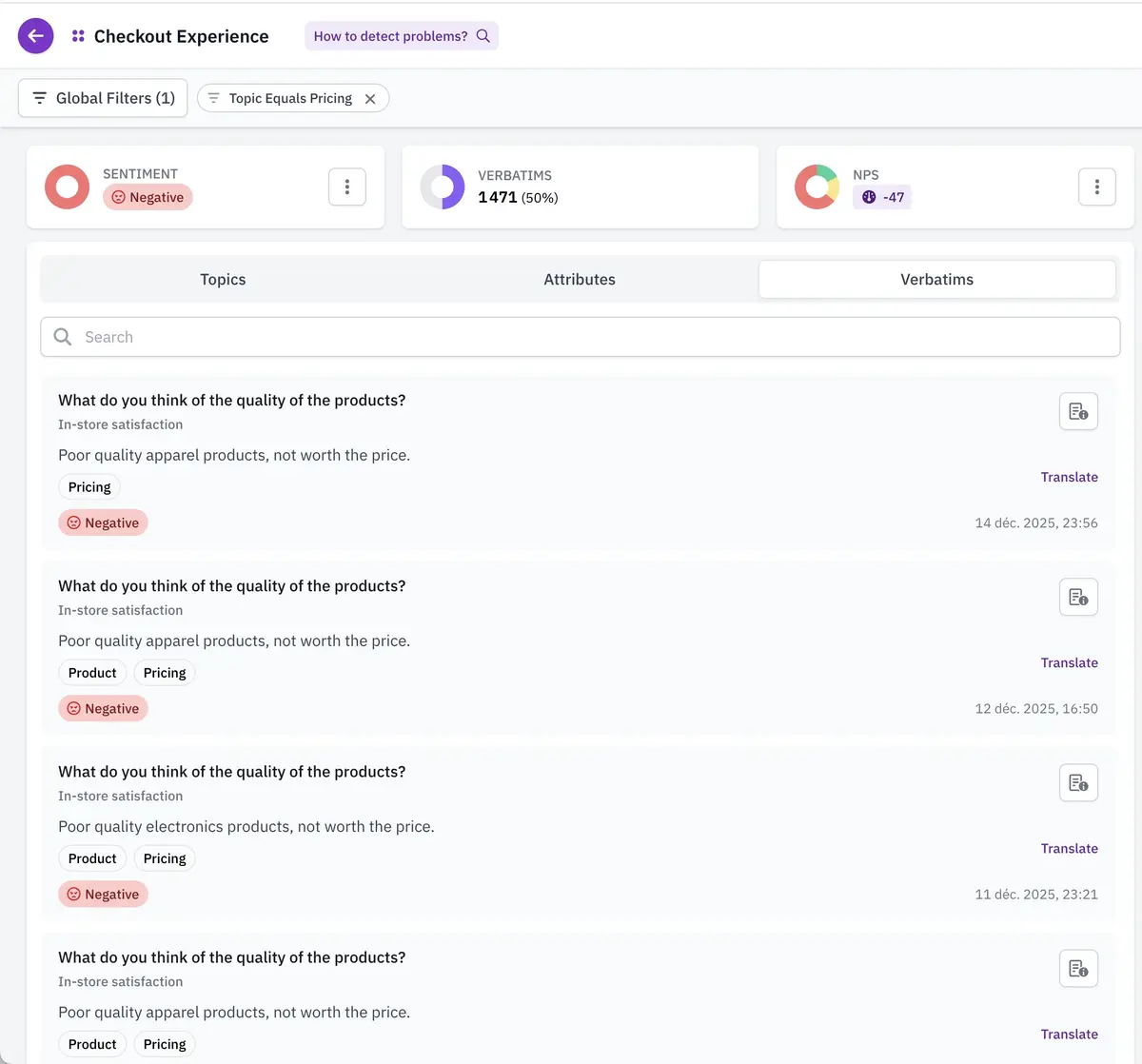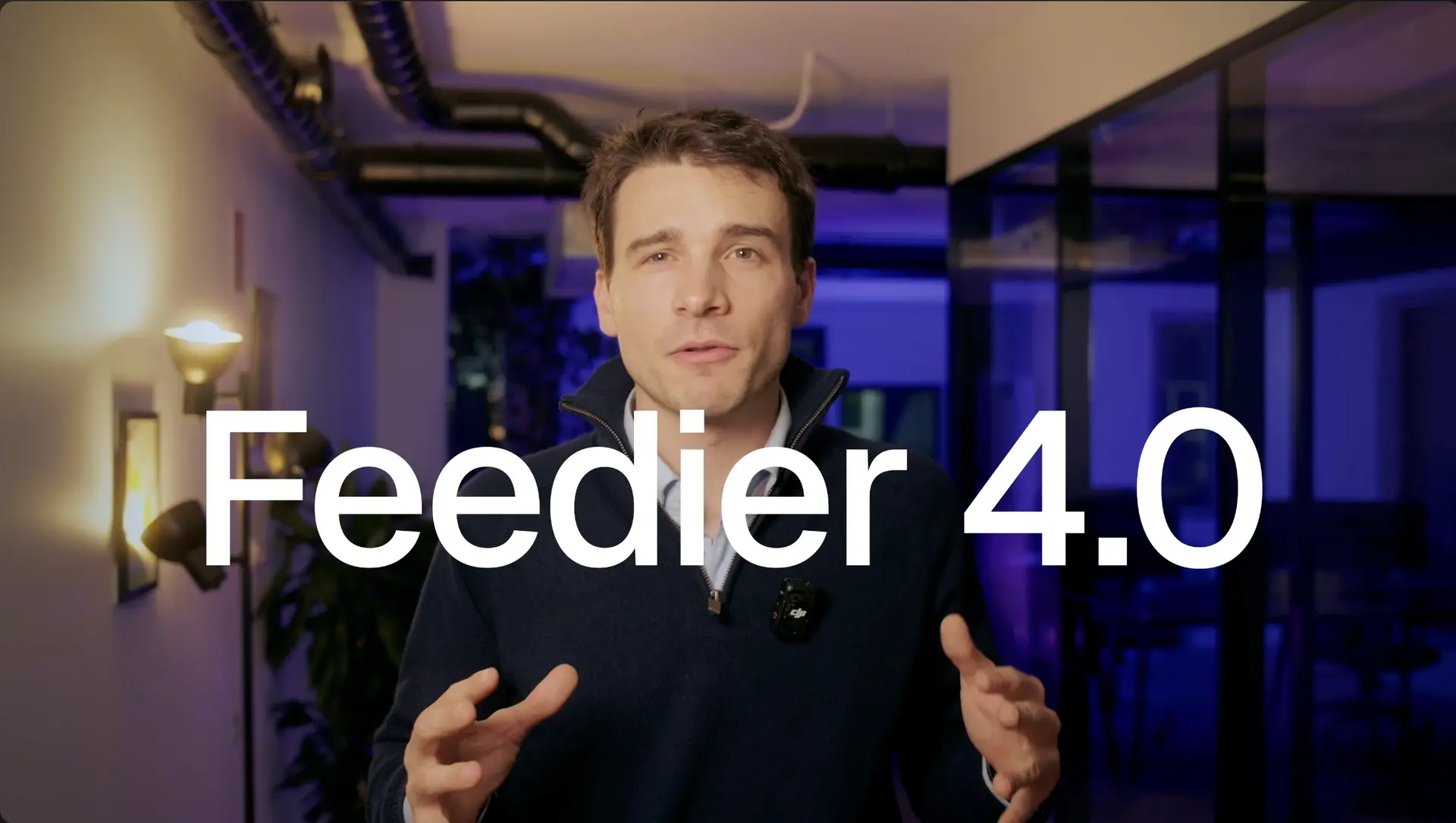
How to analyse open-text feedback with AI and NLP?
.webp)
Companies and teams that are ‘non-data savvy’ or ‘non-tech savvy’ find it difficult to transform. However, companies that make use of them benefit from a major competitive advantage by better understanding their customers and their requirements. Customer verbatim analysis is part of this, as it is a process of examining and deriving insights from written feedback to help companies make informed decisions.
In this article, we'll look at how feedback text analysis can help companies move forward in a way that is sustainable and gives them a competitive edge in their sector.
What is customer verbatim analysis?
Customer verbatim (open-text feedback) analysis is a technology-enabled process that uses computer processing to read and understand the words written by users. It's like having a high-speed reader that can analyse messages such as emails or online notes and tell you what they mean. This method is very useful for companies that want to know what their customers are saying without having to decipher everything themselves.
Machine learning works in two main ways. Firstly, machine learning helps technology to get better at its job by learning from the words it reads. It's a bit like getting better at a game as you play it. Secondly, there is Natural Language Processing (NLP), which means that the computer is trained to understand the way people speak and write naturally.
So when a company uses verbatim analysis, the technology behind the process sorts through all those written words to find useful information. It helps the company to understand what people are saying about it, whether it's good or bad, and then suggest what action to take.
While automatic processing of customer verbatims helps to understand human language, machine learning (learning the algorithm using data) improves the accuracy of textual data analysis and extracts useful information for the business.

Why is customer open-text feedback analysis important for business growth?
Verbatim analysis enables a large volume of data to be analysed quickly and automatically. Trying to read thousands of customer emails or comments on social networks would be a considerable task. However, customer verbatim analysis allows a technology like NLP to take on this task, to go through this data and bring out the most important elements. For example, if customers are not satisfied with a product and express their dissatisfaction online, verbatim analysis will highlight this, helping companies to take rapid action to improve.
Sentiment analysis

This method of data analysis focuses on the feelings or opinions expressed in the text. Are people happy or upset? By looking at reviews or social networks, sentiment analysis can help you find out what customers are feeling and why. This is very useful for solving problems before they escalate or for finding out what people like about your products.
Managing your data properly
Feedback text analysis can also be used to organise data and files. In a legal database, for example, client verbatim analysis enables you to find the exact documents you are looking for from among millions of others. This is a real help when it comes to managing information in institutions such as hospitals, law firms or insurance companies.
How does customer feedback analysis work?
Definition of a customer verbatim
A customer verbatim refers to the raw comments made by customers about a company, brand, product or service. These comments are generally obtained through satisfaction surveys with open questions or free text spaces. They are used to support a rating or to express opinions on specific aspects.
Verbatim analysis trains Language Modeling (LM) to understand the meaning and context of words, just as people learn the meaning of new words. It is based on two main technologies: Deep Learning and Natural Language Processing (NLP).
Here is an example of Language Modelling used to synthesise a large volume of text:

Deep Learning: This is a specialised type of machine learning, part of artificial intelligence. Deep learning uses what are known as neural networks to help computers understand texts in much the same way as a human brain would. In this way, customer verbatim analysis becomes an excellent tool for reading and understanding words.
Natural Language Processing (NLP): is a way of teaching computers to understand human language. It uses various techniques to train models so that they can process and give meaning to written text, even if it is handwritten. Functions such as optical character recognition (OCR) enable text images to be transformed into readable documents.
The two types of Language Model (LM)
N-gram model
An n-gram language model is an approach to analysing the way words are ordered in a text. It assumes that the probability of the next word in a sequence depends only on a group of preceding words of a specific size. For example, a bigram model takes into account only one preceding word, a trigram model uses two, and so on.
In general, an n-gram model examines the preceding words in the sequence, up to a total of n-1 words, to predict the next word. However, it is essential to note that n-gram models are no longer widely used in natural language processing research. They have been overtaken by more advanced deep learning methods, such as large language models, which have been shown to perform better.
LLM (Large Language Modeling)
A large language model, or LLM, is based on vast collections of texts from different sources, such as books, press articles, web pages, forums and social networks. Its aim is to predict the words and phrases that follow a given word in a text. These models are powerful tools used in a variety of fields. This model can be illustrated as a vast neural network.
LLMs are used for a multitude of tasks. For example, they are used to generate text, automatically translate from one language to another, classify text documents, and even answer questions. Some of the most famous examples of LLMs include OpenAI's GPT-4 and Google's BERT.
Open-text feedback analysis in Customer Experience
To improve the customer experience, it's important to understand what customers are saying, and verbatim analysis is a key part of this process. Text analytics enables businesses to quickly process large amounts of unstructured feedback data and make sense of it, turning it into actionable information.
Customer verbatim analysis also enables companies to track changes in customer sentiment in real time. This is useful information that can be used to improve products, services or communication strategies to better meet customer needs and expectations. In this situation, text analysis is a powerful tool for keeping customers happy and building long-term loyalty.
The 2 methods used to analyse open-text feedback
Entity detection
Entity detection is the process of recognising and classifying key elements in a text, such as names, companies or places. This helps companies find specific elements that customers have mentioned about their products or services.
Here is an example of how to classify key elements:

Entity detection is the process of recognising and classifying key elements in a text, such as names, companies or places. This helps companies find specific elements that customers have mentioned about their products or services.
Sentiment analysis
On the other hand, sentiment analysis evaluates the emotional tone of the text to determine whether the feedback is positive, negative or neutral. By using these text analysis methods, companies can find out more about what customers are saying. This will help them to address issues and make the most of customer feedback.

The benefits of text feedback analysis in customer experience management
Text analysis has many benefits for businesses. It can help them learn important things and make good decisions. Here are some of the most important benefits:
- Improved understanding of customers: It allows companies to draw useful information from customer feedback, giving them a better idea of their needs, preferences and hot and cold irritants.
- Efficient data processing: Companies can save time and money by automating the study of large quantities of unstructured textual data. Teams can then concentrate on more strategic tasks.
- Real-time intelligence: Verbatim analysis enables companies to monitor customer sentiment and new trends in real time. This makes it easier to deal with problems quickly and seize opportunities.
- Data-driven decision making: Giving businesses the information they need to make intelligent, data-driven choices about product development, marketing strategies and improving customer service.
- Improved customer experience: Customer verbatim analysis helps companies to improve their offerings and give their customers an exceptional experience by showing them where they can improve and by dealing with customer complaints upstream.
- Competitive edge: text analytics gives companies a competitive edge because it helps them stay ahead of the competition by constantly evolving to meet customer wants and expectations, resulting in long-term loyalty and growth.
Optimising the value of customer verbatim analysis
There are several stages in the process of optimising verbatim analysis. To fully exploit its power, it is important to focus on centralising feedback and reporting in real time, using solutions such as those offered by Feedier.
Step 1: Centralise all your feedback data
Centralised feedback streamlines the text analysis process by centralising customer feedback from various sources on a single platform:
- Comments on social networks.
- Online review websites such as Google Reviews or Trustpilot.
- Email and SMS campaigns.
- Satisfaction surveys.
- Customer support tickets.
This global approach provides an overview of customer sentiment and experience across multiple touchpoints. It makes analysis more effective and, above all, far more insightful and accurate.
Step 2: Generate and share reports in real time
Real-time reporting is a key element in making the most of text data processing. By generating automated reports and graphs that are accessible to all employees, companies can monitor customer behaviour and emerging trends. This enables them to quickly identify and resolve any incidents or capitalise on positive feedback.
Feedier strengthens the ability of companies to remain agile and flexible in response to customer needs, by supporting data-driven decision-making. With Feedier's 360 Voice of Customer solution, companies can strategically adapt their products, services and communication efforts based on real-time customer feedback. As a result, customer satisfaction is enhanced and long-term results are improved.
Step 3: Enrich your feedback data with your business data
Integration with other business tools makes the process even more useful. It ensures that every piece of feedback is enriched by customer data and vice versa. By connecting a textual data analysis solution like Feedier to tools such as CRM systems, support software and marketing automation platforms, companies can easily synchronise customer feedback data and information.
This integration makes it easier to understand customer interactions and sentiments in a more consistent way, improving the analysis process. It also makes it easier for teams from different departments to work together and make informed decisions. They can access and exploit the information obtained. As a result, companies can implement more targeted strategies, address customer friction points and improve their offerings. The result is a better customer experience and business growth.
To sum up
Text analytics is a powerful tool that uses Machine Learning and Natural Language Processing to extract actionable intelligence from unstructured data. Companies can make the most of it by centralising feedback, setting up real-time reporting and integrating it with other business tools. It helps companies stay ahead of the competition, which translates into long-term growth and customer loyalty. Text analytics is a good investment for any business looking to improve its products and services and better serve its customers.
The Ultimate Guide to the Voice of the Customer 2025

Florian is Marketing Manager at Feedier, responsible for brand development, demand generation and inbound and outbound lead generation.
Our articles for further exploration
A selection of resources to inform your CX decisions and share the approaches we develop with our clients.



